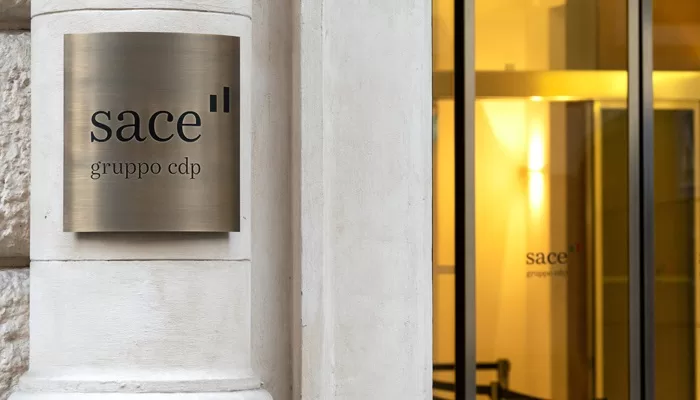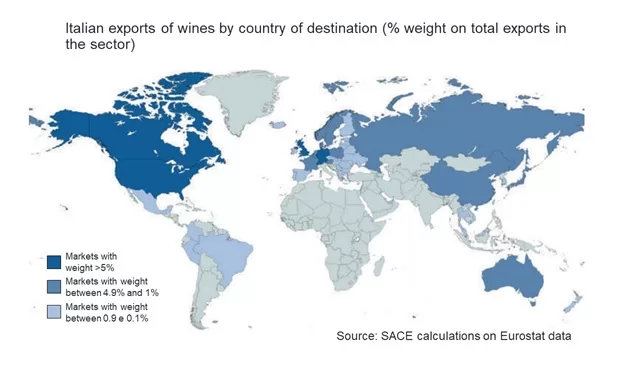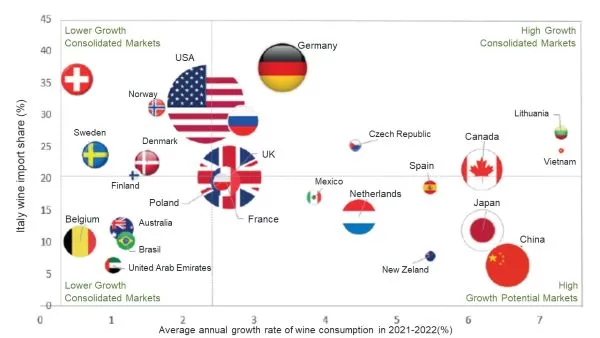Reports and Insights
Italian Wine Exports: A Glass Half-Full

Like others, the wine sector suffered a setback in 2020 because of the pandemic. While, at the domestic level, it was the lockdown that negatively affected alcohol’s purchase and consumption, at the international level, the disruption of trade was the element worsening the sales trend. Moreover, despite the decrease in demand (-2.9%), 2020 saw an increase in supply: indeed, thanks to more favourable climatic conditions, it saw a slight increase in world wine production compared to 2019 (+0.8%), for a total of 260 million hectolitres. Of these, 49.1 million were Italian wine.
In detail, as observed in the Wine&Spirits Report published by SACE, Italian manufacturers ended 2020 with a 4.1% decrease in sales, with a significant gap between performance on the domestic (-6.3%) and international (-1.9%) market. On the other hand, looking at wine classes, sparkling wines were hit harder, with a 6.7% decrease, than still wines, whose decrease was limited to 3.5%.
It should come as no surprise, therefore, that investments by producers also decreased (-14.3%), choosing to focus more on digitisation, which saw investments soar by 55.8%.
However, after such a complex year, 2021 portrayed a very different scenario. Indeed, as confirmed by the data reported in SACE’s Un Export da Bere (Exports to Drink) study, Italian wine exports started to grow again, not only compared to 2020 (+14.5%), but also compared to 2019 (+10.7%), for a total value of 4 billion euros. Moreover, sparkling wines, those hardest hit in 2020, regained ground with an average growth of over 40%.
At the territorial level, the ranking of Italian regions with the highest wine exports remained unchanged between 2020 and 2021, confirming Veneto in first place, followed by Piedmont and Tuscany.
Looking at exports, the largest target market for Italian wines, also in 2020, was the United States, representing 23.1% of national exports, with a 5.6% decrease compared to 2019. The silver medal went to the Germany, which accounted for 17.1% of all Italian exports, with even a 3.9% growth compared to 2019. Great Britain was in third place (11,4%) with a 6.4% decrease in sales, due partially to the effect of the entry into force of Brexit.
But, other important markets such as European ones – Switzerland, the Netherlands and Eastern Europe – and non-European ones – Canada, Japan, China, Vietnam, should not be forgotten.
(Fig. 1)

Expectations for 2021-2022 are positive, with a general increase in wine consumption for all the markets under review (+3.8%). Among these, the United States and Germany stand out, but China is the market showing the most of potential, with a growth in wine consumption of + 6.3%. (Fig. 2)

“When we speak of wine and spirits – says Alessandro Terzulli, SACE Chief Economist – we refer to an item that represents 30% of Italian agricultural and food exports. In 2020, which had been inevitably a negative year, wine exports reached -1.6%. Despite this, 2021 saw significant sales gains and expectations for 2022 are also very favourable. The robust growth leads us to confirm a two-fold strategy to address foreign markets and seize more structural elements of demand. On the one hand, it is essential to consolidate our presence in growth markets, such as the United States and Germany. While, on the other, it is necessary to direct efforts to establish a foothold in areas with great growth potential, such as the Chinese and Japanese markets, or to penetrate markets of smaller dimensions, but with rapid growth, such as Vietnam and some Northern European countries.”
Now, in January 2022, we can say that 2021 confirmed expectations. In fact, between January and October 2021, the export of wines marks + 13.2% compared to the same period in 2020. Thanks to the vaccination campaign that allowed the restrictive measures, which in 2020 had negatively affected trade and travel, to be partially reduced, 2021 not only saw an increase in sales of Italian wines, both on the domestic market as well as abroad, but also saw the resumption of events and fairs, such as Vinitaly. For example, 400 exhibiting companies and consortia among the most prestigious in Italy attended the Special Edition of October 2021, as well as 200 top foreign buyers, sending a positive message of recovery of the sector.




















































